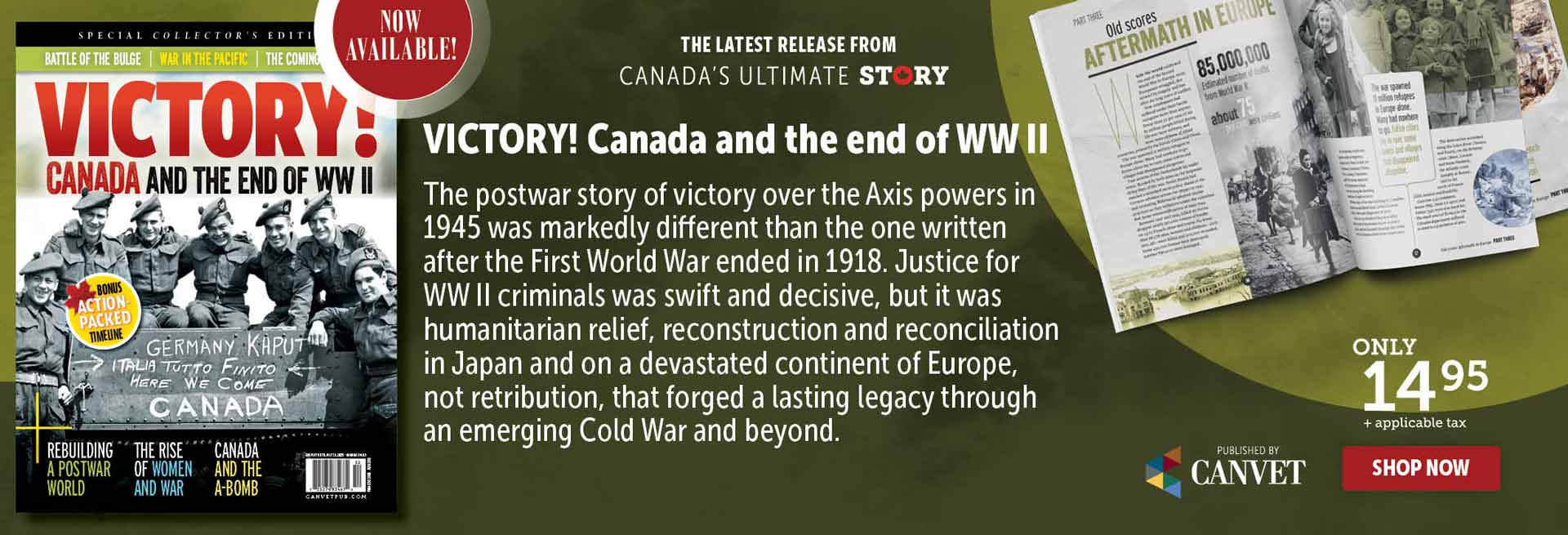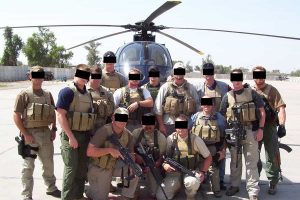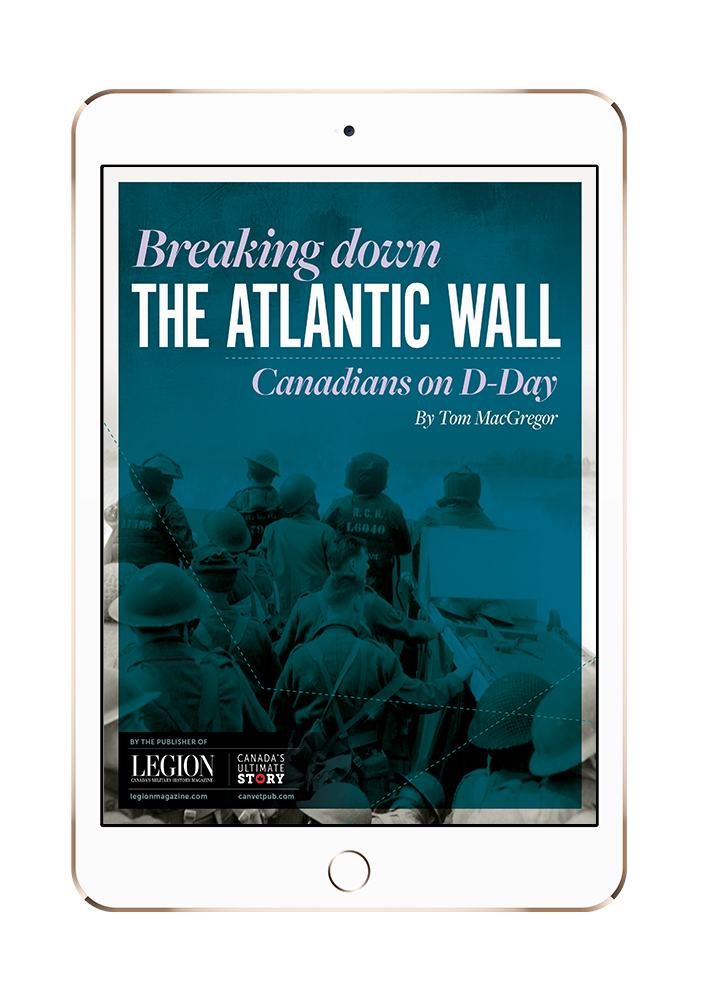
Méharicourt Communal Cemetery is the final resting place of numerous Canadian airmen, including Victoria Cross recipient Andrew Mynarski.[Poppy Mercier]
Etched into the white—if weathered—gravestone is the symbol of the Commonwealth’s highest military honour, earned on June 13, 1944, when the Royal Canadian Air Force airman attempted to save a trapped member of his crew while his crippled Lancaster bomber burned around him. Mynarski did not survive, but his devotion to a fellow airman would be remembered.
Immediately beside his final resting place, however, are the names of lesser-known Canadians, who, aboard a different aircraft—KB714—also sacrificed their lives on the same bombing mission that night. Among their number was 28-year-old Flying Officer Russel Nelson Wilson from Landis, Sask., serving with 419 (Moose) Squadron when the pilot and his six other crew members perished amid operations to destroy railyards at Cambrai. Their plane crashed in the Somme, near Courcelette.
More than 80 years later in that small village, local historian Poppy Mercier—having moved to France from the U.K.—has begun a journey to honour their legacy, researching their stories and, in doing so, putting faces to names. One day, she envisions a Courcelette memorial to the Canadians.
Mercier spoke to Legion Magazine about her efforts.

Local historian Poppy Mercier researched the identities of the Canadians in Méharicourt Communal Cemetery. [Poppy Mercier]
I was born in Sussex [Southeast England] and later lived in Kent for about 10 to 12 years, but I mostly grew up in northern France as a very small child. I have a lot of memories of living near the old First World War battlefields, where I learned about the history of the local area from both my parents. Both of them are also historians.
In my mid-teens, I decided that history would probably be my career. I have since started work as a tour guide teaching school groups about the world wars, as well as being an avid militaria collector, writer, photographer and, of course, historian.
Courcelette, where I live, was actually a Canadian battlefield in September 1916. I’ve met and guided many Canadians over the years, highlighting their ancestors.
About her connection to KB714
When my parents first arrived [in France] in the early ’90s, they befriended a local couple, Yves and Christiane Foucat. When I came along in the late ’90s, they kind of became my surrogate grandparents. Yves and Christiane had grown up on the Somme during the [Nazi] occupation. For Christiane, the war was very difficult.
Meanwhile, with Yves, there’s some potential that he might have been involved in some sort of local resistance group, but I’ve never been completely sure about that.
Where we are on the Somme means we’re close to lots of tactical railway stations. Of course, the RAF and USAAF were constantly bombing the area so as to hinder strategic [German] troop movements, especially just before D-Day and afterward.
Yves apparently always watched out for these fly overs. On the night that KB714 was returning to the U.K. from bombing railyards in Cambrai, it flew right over our part of the Somme, directly over Courcelette. Now, there seems to be some uncertainty about what actually happened. Either KB714 was hunted by night fighters here, or it was hit by flak fire elsewhere, and here is where it crashed.
Yves’s friend watched the plane come down. I now have its salvaged compass, which was gifted to my grandfather by his friend and later passed down to me.
About researching the airmen’s fate
Because we’re currently in that period around the 80th anniversary of many major battles of the Second World War, it got me thinking about what connections there are in my specific area. A couple of years ago, the French released a new website called Retro News where you can basically search local newspaper archives, so I did that for Courcelette. The first thing that appeared was an article on an aircraft shot down in flames. I wondered if it was the one I was told about as a youngster.
I started researching it a bit more, and I stumbled upon a forum talking about the Royal Canadian Air Force and their bombing raids in this sector in 1944. That’s when I saw KB714 with Flying Officer Russel Nelson Wilson listed as the pilot.
I remember being like, “that must be it.”
My research went from there. I went through the archives to see what I could find. I went through each of the [airmen’s] individual service files, which are available online as they’re deceased. Now, we’re uncertain where the aircraft crashed apart from it being outside the village. It seems to be somewhere south of Courcelette, although one source says one thing and another source says something different.
There’s also some debate as to whether the aircraft crashed or crash-landed. All I know is that there was a fire on board, and possibly two airmen tried parachuting out—their bodies were found a week later. How they were shot down in the first place is another contentious issue. It’s possible that the same [German] pilot who shot down [Victoria Cross recipient] Andrew Mynarski also downed KB714, but we must consider that pilots can be eager to claim kills that are not always theirs.
About paying tribute to the fallen Canadians
It’s really touching paying my respects at the cemetery, especially going to see the air bomber [Flying Officer Charles Robert McOrmond of Winnipeg] as I think it’s his compass I have. I was determined to try and get photos of each one of them to place beside their graves, which I did. It’s quite something putting faces to names.
I eventually plan on broaching the subject of potentially having a small memorial in Courcelette. We have a couple of Canadian memorials to regiments of the First World War. I’m hoping one day to have something similar for the crew of KB714. It doesn’t have to be anything grandiose, nothing fancy, just a commemoration to recognize that they were here, in Courcelette, and they paid the ultimate sacrifice.
Just a little something to remember them.
This abridged interview has been edited for brevity and clarity.
Advertisement





















